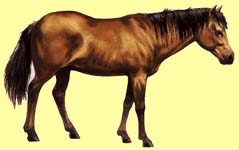|
|
Australian Brumby |
|
|
Australian Brumby |
 During the mid-nineteenth century gold rush, domestic horses were turned loose on the ranges of Australia. The Brumby developed from these horses as they became somewhat inbred, losing their original qualities. These horses formed herds and lived off poor grazing land which contributed to the deterioration in their quality. The horses became shorter, and they became hardier. They thus required less food. Primitive coats reappeared for camouflage. The shoulder became straighter which, while allowing less freedom of action, provided greater speed enabling the horses to take flight at the onset of danger.
During the mid-nineteenth century gold rush, domestic horses were turned loose on the ranges of Australia. The Brumby developed from these horses as they became somewhat inbred, losing their original qualities. These horses formed herds and lived off poor grazing land which contributed to the deterioration in their quality. The horses became shorter, and they became hardier. They thus required less food. Primitive coats reappeared for camouflage. The shoulder became straighter which, while allowing less freedom of action, provided greater speed enabling the horses to take flight at the onset of danger.
During the Boer and First World wars, horses were gathered from all over Australia for mounted regiments. Following these wars, remaining horses were turned loose, and the number of Brumbies again increased. Thriving and becoming numerous, the Brumbies became labeled as a pest. They threatened agriculture, damaged fences, grazing the land and drank from the water holes. Ranchers organized to cull the Brumbies and reduce their numbers, which were interferring with the cattle and sheep ranges. The Brumbies, however, became remarkably cunning and made the culling efforts difficult. Since 1962, though, the culling has brought the Brumby to near-extinction and few are found wild today.
Standing around 15 hands high, these horses are invariably intractable and difficult to train if they are caught. The term brumby is probably derived from and aboriginal word for wild, baroombi. They are mesomorphic in type, and come in any color. The Brumby has a rather heavy head, short neck, straight shoulder, short back, sloping croup and strudy legs. These wild horses face extinction due to the culling efforst of the ranchers much as the American Mustangs of the West did in the 20th century. Why 'Brumbies'?
There are many tales as to the origin of the name 'Brumby.' One story goes that the horses were named after an early settler called James Brumby. He abandoned his horses in Australia in 1804. Another legend claims that the name stems from the Aboriginal word "baroomby" which means 'wild.' Yet another idea is that the word comes from "barumba" the name of a creek and cattle station in Queensland.
For more information visit:

|
© 1997-2007
NW Breyer Horse Club & Refiner of Gold Creations Equinealities in place since 1997, Section in place 2001, Updated 3/13/2007 |



|
| ||

|
|||||